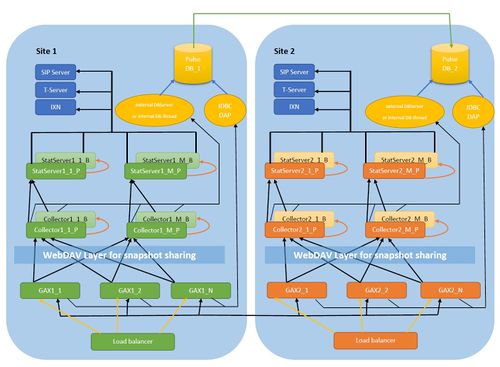Multi-site Architecture
Multi-site Architecture allows Genesys Pulse to work in multiple data centers with traffic minimized between sites for Disaster Recovery (DR) purposes.
- Genesys Pulse, Genesys Pulse Collector, Stat Server are recommended to be on their own dedicated hosts (VMs), but all can be deployed on the same host.
- Scale Genesys Pulse initially using vertical scaling (change the host/VM specs). After that, you can add more Genesys Pulse VM pairs to both Site 1 and Site 2 clusters.
- Each Genesys Pulse Collector can handle about 300K statistics with a 10-second refresh rate opened on Stat Server. Adjust this amount based on the refresh rate.
- Note: If you use Changes-based notifications for anything other than Agent Current State, you might have a significant number of notifications for each of these statistics per second. You must configure the sensitivity to account for these additional notifications in sizing.
- Use a dedicated Stat Server for each Genesys Pulse Collector:
- Each Genesys Pulse Collector supports only a single connection to Stat Server (HA pair).
- In a cluster configuration, all Stat Servers used for all Genesys Pulse Collectors must be connected to the same sources, such as T-Servers, SIP Servers, and Interaction (IXN) Servers.
- In a cluster configuration, the statistics are dynamically distributed across all Primary Genesys Pulse Collectors. You can have up to 256 Primary Genesys Pulse Collectors for each Site (‘M’ in the name of Genesys Pulse Collectors on diagram).
- In a cluster configuration, each Genesys Pulse instance can render the statistics and views across all Genesys Pulse Collectors on the same Site.
- For High Availability (HA), you need a pair of Genesys Pulse Collectors.
- Genesys Pulse, Genesys Pulse Collector, Stat Server, and DB Server should exist and be operational on both Sites (Site 1: Main region and Site 2: DR region).
- Both GAX and Genesys Pulse Collector application objects should have the site option set in pulse or collector sections respectively, representing the operational site name (to form Genesys Pulse - Genesys Pulse Collector pairs on each Site).
- Genesys Pulse databases are replicated from Site 1 to Site 2 through periodic backup and restore processes using the capabilities of RDBMS (for example, one-way log shipping or bi-directional regional replication using Postgres BDR).
- If a one-way database replication is used (Site 1 to Site 2), Genesys Pulse on the DR site functions and serves data in read-only mode. You cannot edit dashboards, widgets, or templates on the second site.
- Use WebDAV to let Genesys Pulse pull snapshot data from an instance of Genesys Pulse Collector that is not installed on the same host. Genesys supports Lighttpd http server with lighttpd-mod-webdav on UNIX and IIS on Windows.
- You can use the Site 2 for customer validation of changes and capabilities, before placing them into production (Site 1). In this case the Site 2 cluster needs to be active only before an upgrade is performed.
This page was last edited on April 27, 2018, at 03:57.
Comments or questions about this documentation? Contact us for support!

